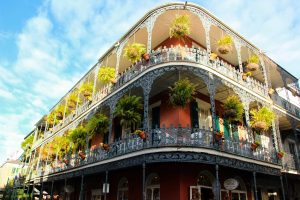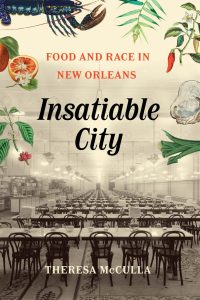Five Questions with Theresa McCulla, author of “Insatiable City: Food and Race in New Orleans”
In Insatiable City, Theresa McCulla probes the overt and covert ways that the production of food and the discourse about it both created and reinforced many strains of inequality in New Orleans, a city significantly defined by its foodways. Tracking the city’s economy from nineteenth-century chattel slavery to twentieth-century tourism, McCulla uses menus, cookbooks, newspapers, postcards, photography, and other material culture to limn the interplay among the production and reception of food, the inscription and reiteration of racial hierarchies, and the constant diminishment and exploitation of working-class people. The consumption of food and people, she shows, was mutually reinforced and deeply intertwined. Yet she also details how enslaved and free people of color in New Orleans used food and drink to carve paths of mobility, stability, autonomy, freedom, profit, and joy. Read on for an interview with the author about her research.
What is Creole cuisine? And why have the definitions of “Creole” food and Creole people been debated for generations?
Creole cuisine is the food of New Orleans. That’s the short and simple answer, but the history of the word “Creole” in Louisiana has been anything but short or simple. Initially, Europeans used the term “Creole” as a geographic identifier, to distinguish someone born in a colonized place. New Orleans Creoles were of European, African, Afro-Caribbean, and mixed lineages. After the Civil War, however, notions of race coalesced, and the line between Black and white hardened. You see a concerted effort among many white New Orleanians to excise anyone of African descent from being considered a Creole. White guidebook authors, local historians, and tourism boosters asserted that the word “Creole” meant “white” and derived from a romanticized, aristocratic French and Spanish past. This claim was an attempt to delineate difference and protect white racial privilege within a segregating society.
Such denials gained an economic dimension as the twentieth-century city’s economy came to rely increasingly on tourism—who would reap the profits when tourists flocked to Creole restaurants?—as well as a more nebulous dimension that had to do with cultural belonging, creativity, and ingenuity. Who could claim that they had invented and perfected this iconic cuisine? Who had created the culture of this popular tourist destination? New Orleanians of color who identified as Creole never acquiesced to attempts to exclude them. Caterer and TV personality Lena Richard, who published a cookbook in 1939, proudly proclaimed herself and her cooking to be Creole. So did restaurateur Leah Chase, who helmed longtime Tremé restaurant Dooky Chase. More recently, poet Mona Lisa Saloy stated succinctly, “Creole is not a color, it’s a culture.” Creole cuisine is—and always has been—the food, people, culture, and history of New Orleans, in all its rich diversity.
Much of New Orleans’s wealth and development were built on sugar, and its production was intertwined with brutality. Tell us more about this industry in Louisiana, as well as its lasting legacy.
Looking at the long history of food in New Orleans produces difficult, if not ugly, histories of a place that many people enjoy specifically for its comforts. Sugar presents one of the best examples of this fact. Cultivating, harvesting, and processing sugarcane—a crop that Louisiana dominated in the United States until the turn of the twentieth century—was excruciating work. The industry’s physical demands drove New Orleans’s slave market to become the largest in the country.

Sugarcane grows in dense rows, with blade-like leaves, up to nine feet high. During harvest season, overseers drove laborers around the clock to fell the cane with hook-tipped machetes. Inside the plantation’s mill, workers fed the cane into steam-powered metal rollers, which crushed and shredded the stalks. In the boiling house, laborers stood over open-topped kettles where cane juice was concentrated into molten syrup. Laborers risked mechanical injuries, burns, exhaustion, malnutrition, violence, and the hazards of the fields’ snakes, rats, and mosquitoes.
Following the Civil War, many free Black Louisianians were compelled to keep growing cane, as impoverished sharecroppers on the same properties where they had been enslaved. Authorities also constructed penitentiaries, such as Angola State Farm and Hope State Farm, on the sites of former plantations. There, they forced inmates—nearly all Black men—to grow and harvest sugarcane (in some places, to the present day). Other sugar plantations were converted into wedding venues and tourist destinations. A stretch of land along the Mississippi River formerly dedicated to sugar production is now dubbed “Cancer Alley.” Home to plastics and chemical plants, its local residents suffer some of the nation’s highest cancer rates. In all of these ways, sugar’s brutal legacy on the land and people of Louisiana has been long-lasting.
Despite enormous challenges, Black entrepreneurs in New Orleans used food and drink to purchase freedom from slavery; achieve mobility, stability, autonomy, freedom, profit, and joy; and fight for their civil rights. Who are some of the Black culinary food workers described in your book, and what were their stories?
Insatiable City details the many ways in which food and food work were often wielded as means of subjugating New Orleanians of color, whether under slavery or within the strictures of twentieth-century segregation. Nevertheless, Black New Orleanians of every era used these same tools to build freedom, belonging, and pleasure for themselves, their families, and their communities.
For example, an enslaved woman named Catherine sold apples and oranges onboard Mississippi River steamboats. Bit by bit, dollar by dollar, she saved $1,200—the price her enslaver had demanded from her to buy her freedom. After Catherine purchased her freedom, she returned to steamboat vending to buy the freedom of her sister, Charlotte, too. Lucette Barberousse was also a vendor, working as a marchande in New Orleans’s streets. Born in the French colony of Saint-Domingue (now, Haiti), Barberousse used the profits from her work to purchase the freedom of three of her daughters. In the 1840 federal census, Barberousse appeared as the head of a New Orleans household of nine women of color. Her entrepreneurial work enabled her to sustain her multi-generational family. Fast-forwarding a century, Chef Leah Chase outfitted her Tremé restaurant, Dooky Chase, with white tablecloths, comfortable chairs, and the work of Black artists. Chase had experienced the fact that Black cooks and servers produced the aesthetic and gustatory experiences of Creole fine dining but were prohibited from sitting in the dining rooms of the city’s restaurants to enjoy those meals. With her restaurant, Chase finally provided a place where Black diners could feel at home and enjoy fine Creole meals. She fed civil rights activists, celebrity athletes, politicians, and neighborhood regulars, too. “I feel like in this restaurant we changed the course of the world over bowls of gumbo,” she said in an interview.
Documenting the histories of creative food entrepreneurs such as these was one of the most exciting and gratifying aspects of writing this book.

Researching food and race requires a creative amalgamation of sources and research methods. This history does not emerge from tidy archives. How did you go about researching the book?
Official records and archival collections that might detail the histories of people of color working in New Orleans’s food industry often yield unreliable or scant returns. This is in part because historical authorities categorized the labor of making and serving food as menial and unskilled. Food workers and servers were often women, people of color, immigrants, enslaved, recently manumitted, or fugitives from slavery (or a combination of several of those things). They were the working poor, stitching together multiple jobs, and on the move. Accordingly, I reached for an interdisciplinary array of sources—and interpreted them side-by-side—to document the women and men who filled the ranks of New Orleans’s fields and kitchens, often laboring out of sight from diners and scholars.
These included sources like emancipation petitions and judicial records in French and English; published autobiographies and interviews of formerly enslaved people; travel guides and travel narratives; and even a deathbed confession that included passing mentions of transient work in urban pastry kitchens. A notary’s inventory of a nineteenth-century luxury hotel offered material clues to the objects handled by enslaved servants in their daily work: silver serving spoons, crystal wine glasses, fine bed sheets. Architectural plans hinted at how these workers may have moved through the spaces where they were enslaved. Postcards and stereographs depicting New Orleans’s levees and sugarcane fields—sources typically associated with tourism and popular culture—can be read for the light they shed on the region’s food and labor histories and the social status of their workers. Menus, cookbooks, and letters about cooking specified the textures, aromas, flavors, and techniques of public and private meals. The histories of the people, places, and meals explored in Insatiable City are textual, oral, visual, and gustatory, and the sources and research methods reflect that diversity.
How can the subject of food help us better understand evolving ideas and terms related to race and ethnicity?
Race and ethnicity are changing and subjective ideas, nearly impossible to define and document. Similarly, food wilts and rots, and eating and drinking are ephemeral experiences. All of these subjects are evanescent, yet these topics—and the relationships, cultures, and economies that emerge from them—have concrete repercussions on people’s lives, historically and today. For this reason, I’ve long been fascinated by the relationship between food and identity—the deep meanings that people attach to and draw from food and drink to understand who they (and others) are.
In every era considered in Insatiable City, a consistent theme emerged: the repetition of experiences of consuming and consumption that revolved around food and people, bound together. As articulated by the people I studied, such experiences were always inflected by evolving understandings of race. Nineteenth-century tourists in New Orleans described food workers’ bodies, especially the color of their skin, in terms of the sugar and coffee they made or sold. Early visitors blended their appetites for the city’s food and drink with their fascination with the city’s slave markets. These were twinned entertainments, experienced together. Even with the passage of time, little changed. On the shelves of twentieth-century French Quarter souvenir shops, cookbooks and trinkets proliferated with visual stereotypes of Black women cooking and selling food—stereotyped “mammies”—even as many whites clung to segregation. Whether in the nineteenth century or the twentieth, then, many white diners and tourists wanted the labor of Black New Orleanians, the food they made, and the idea of Black New Orleanians in the kitchen, but they pushed the people away, seeking to objectify and commodify them. Regardless of the era or setting, food opens the door to these intimate, challenging histories of people, place, and identity.

Theresa McCulla is a curator and historian, and the former curator of the American Brewing History Initiative at the Smithsonian Institution’s National Museum of American History.
Insatiable City is available now from our website or your favorite bookseller.
